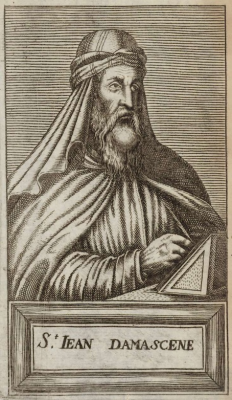Gospel in Art: Feast of Saint John of Damascus

Saint John of Damascus, Engraving by André Thevet, 1590 © Christian Art
Source: Christian Art
Gospel of 4 December 2024
Matthew 15:29-37
At that time: Jesus walked beside the Sea of Galilee. And he went up on the mountain and sat down there. And great crowds came to him, bringing with them the lame, the blind, the crippled, the mute, and many others, and they put them at his feet, and he healed them, so that the crowd wondered, when they saw the mute speaking, the crippled healthy, the lame walking, and the blind seeing. And they glorified the God of Israel.
Then Jesus called his disciples to him and said, 'I have compassion on the crowd because they have been with me now three days and have nothing to eat. And I am unwilling to send them away hungry, lest they faint on the way.' And the disciples said to him, 'Where are we to get enough bread in such a desolate place to feed so great a crowd?'
And Jesus said to them, 'How many loaves do you have?' They said, 'Seven, and a few small fish.'
And directing the crowd to sit down on the ground, he took the seven loaves and the fish, and having given thanks he broke them and gave them to the disciples, and the disciples gave them to the crowds. And they all ate and were satisfied. And they took up seven baskets full of the broken pieces left over.
Reflection on the engraving
Saint John of Damascus (c. 676-749), Priest and Doctor of the Church, holds an important place as one of the earliest and most significant defenders of sacred images, making him one of the most important saints for the arts. It is no surprise that he is among my favourite saints.
Also known as John Damascene, he was a distinguished theologian and monk whose principal contribution to Christian thought was his passionate defence of the veneration of sacred images. This defence is most famously articulated in his seminal work, On the Divine Images (or Apologia Against Those Who Decry Holy Images), written during the height of the iconoclastic controversies in the Byzantine Empire. In this treatise, Saint John argued eloquently against the destruction of religious images, asserting their role as tools to facilitate contemplation and devotion, rather than being objects of worship in themselves. His theological reasoning was deeply rooted in the incarnation: since God became visible in the person of Jesus Christ, it is both permissible and beneficial to depict Christ and other sacred figures in visual form. As God created us in his image, God himself used images, and therefore we can do the same, thus participating in God's joyful creative spirit.
Saint John's writings laid the intellectual foundation for the Church's affirmation of sacred art at the Second Council of Nicaea in 787, where the veneration of icons was formally upheld. His defence of sacred imagery not only preserved a tradition of visual devotion but also paved the way for the flourishing of Christian art in subsequent centuries. It is not an overstatement to say that without Saint John of Damascus, we might never have seen the grandeur of Gothic cathedrals, the masterpieces of Michelangelo, or the countless works of sacred art that have inspired generations.
Our engraving is by André Thevet (1504-1590), a French priest, explorer, cosmographer, and engraver best known for his work in documenting the peoples and places of the New World and other regions through travel accounts and illustrations. While primarily recognised as a writer and cosmographer, Thevet's association with engraving is closely tied to the visual depictions of these places., But he also engraved beautiful portraits of Old Testament prophets and his favourite saints, of which St John of Damascus was one.
LINKS
Gospel in Art: https://christian.art/
Today's Reflection: https://christian.art/daily-gospel-reading/matthew-15-29-37-2024/


















